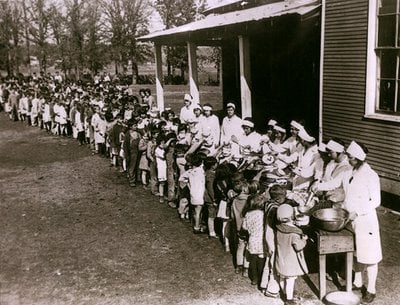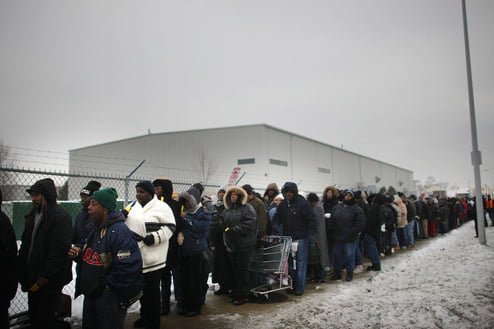With a growing global population and possible supply issues with oil, the OECD is forecasting the potential for a serious global food crisis:
Couple this with the likelihood of a longer term dollar devaluation and price inflation and there is a serious possibility that Americans will be unable to acquire the rations necessary to maintain a healthy diet.
Consider a situation where the SHTF and we run smack dab into a hyperinflationary depression, where the US dollar becomes worthless, goods transportation stops and there is no food to be acquired through our regular just-in-time grocery store inventories. Yes, there may be rations available through the government, but is worrying about where your family will get its next meal something you want to have to do every morning?
While we have always supported the stockpiling of emergency rations like freeze dried goods, dehydrated foods and canned goods, this is only a short-term solution in the event of a protracted depressive cycle (be it inflationary or deflationary).
The next several years, perhaps decades, will make it difficult for average Americans to maintain a healthy diet, even if there is no worst-case collapse event. Food costs will rise. Your wages will go down in real terms, perhaps even completely dissappear if your job is eliminated.
Thus, your only recourse will be to be self sustaining. For those with any sort of acreage available to them, consider micro-farming which includes not just growing vegetables and fruits, but raising chickens, goats, rabbits, and/or fish.
It’s either that, or you can stand in one of these lines for 5 hours a day hoping to get a watery bowl of soup for your kids:

For now, food catastrophes have been limited to the third world, but there is a distinct possibility that the same can happen right here, in the good ‘ol USA.
The picture above is from the Great Depression, and a similar situation is unfolding around the country right now, as depicted by this picture of a food line in Detroit (Dec. 2009):

It’s real and it’s happening in the United States already.
Expect this trend to spread in coming years.
Start thinking about sustainable living, including personal food and energy production – not to save the earth as some environmentalists like to say – but to save yourself.
Author: Mac SlavoFood commodity prices will increase more than previously expected in the next decade because of rising energy prices and developing countries’ rapid growth, two leading organisations said yesterday, worsening the outlook for global food security.President Obama’s new carbon tax will most certainly not reduce food costs going forward, and it is likely that the OECD didn’t even consider this in their calculations. In regards to cap & trade, you can rest assured that not only will your taxes and energy costs go up, but so too will your food costs.
“A return to higher global economic growth . . . together with continuing population gains, are expected to increase demand and trade and underpin prices,” the United Nations’ Food and Agriculture Organisation and the Organisation for Economic Co-operation and Development said in their annual agricultural outlook.
Higher crude oil prices would add force to rising agricultural commodities prices, particularly in those regions – including Europe and the US – where energy inputs such as fertilisers were used intensively, said the report.
For the next 10 years, the FAO and OECD forecast that significant food prices, with the exception of pork, would remain above the 1996-2007 average, in both nominal and real terms – adjusted for inflation. Although prices were unlikely to surge back to the record levels of early 2008, they warned that “if history is any guide, further episodes of strong price fluctuations . . . cannot be ruled out, nor can future short-lived crises”.
source: Financial Times
Couple this with the likelihood of a longer term dollar devaluation and price inflation and there is a serious possibility that Americans will be unable to acquire the rations necessary to maintain a healthy diet.
The prospect of higher prices could prompt those nations dependent on food imports – such as Saudi Arabia and South Korea – to try to secure long-term food supplies by accelerating their investment in overseas agriculture in so-called ” farmland grabs ” deals. Mr GurrÃa said some food-importing nations felt “strategically vulnerable” about their agricultural commodities supplies, but added it was critical to avoid “a race for [food] self-sufficiency“.We would argue that self sufficiency should be the very goal we should be seeking, as a nation and as individuals.
Consider a situation where the SHTF and we run smack dab into a hyperinflationary depression, where the US dollar becomes worthless, goods transportation stops and there is no food to be acquired through our regular just-in-time grocery store inventories. Yes, there may be rations available through the government, but is worrying about where your family will get its next meal something you want to have to do every morning?
While we have always supported the stockpiling of emergency rations like freeze dried goods, dehydrated foods and canned goods, this is only a short-term solution in the event of a protracted depressive cycle (be it inflationary or deflationary).
The next several years, perhaps decades, will make it difficult for average Americans to maintain a healthy diet, even if there is no worst-case collapse event. Food costs will rise. Your wages will go down in real terms, perhaps even completely dissappear if your job is eliminated.
Thus, your only recourse will be to be self sustaining. For those with any sort of acreage available to them, consider micro-farming which includes not just growing vegetables and fruits, but raising chickens, goats, rabbits, and/or fish.
It’s either that, or you can stand in one of these lines for 5 hours a day hoping to get a watery bowl of soup for your kids:

For now, food catastrophes have been limited to the third world, but there is a distinct possibility that the same can happen right here, in the good ‘ol USA.
The picture above is from the Great Depression, and a similar situation is unfolding around the country right now, as depicted by this picture of a food line in Detroit (Dec. 2009):

It’s real and it’s happening in the United States already.
Expect this trend to spread in coming years.
Start thinking about sustainable living, including personal food and energy production – not to save the earth as some environmentalists like to say – but to save yourself.
Website: www.SHTFplan.com
http://t.co/Ulqbq1m

No comments:
Post a Comment